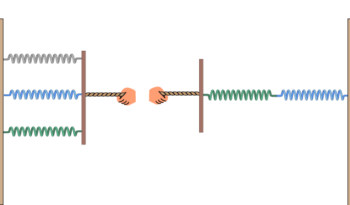Ballistic motion is one of the more elementary problems where the application of Newton’s second law is straightforward. The problem to be considered in the present article is the calculation of the critical angle \(\theta_c\) of firing a projectile of mass \(m\) with initial velocity \(v_0\), that leads to a maximum horizontal reach \(x_{\text{max}}\) when the place of firing is located in a high place (of height \(h\)), assuming that air resistance is negligible. The answer is not \(45\) degrees with respect to the horizontal as is the case when the place of firing is at the same level as the place of landing. There is more than one form of solving the problem. They are very similar, but one of them is more efficient in the sense that requires simpler algebraic calculations. I will explain the two more efficient solutions.
Ballistic motion – Application of Newton’s second law to motion in a plane
The starting point in ballistic motion is the second law of Newton for motion in two dimensions:
\begin{equation}
\begin{split}
m\frac{dv_x}{dt}&=0\\
m\frac{dv_y}{dt}&=-mg\\
\end{split}
\end{equation}
The respective solutions are
\begin{equation}
\begin{split}
x(t)&=x_0+(v_0\cos\theta)t\\
y(t)&=y_0+(v_0\sin\theta)t-\frac{1}{2}gt^2
\end{split}
\end{equation}
In our present case, it is convenient to select the origin of the coordinate system such that the initial position \((x_0,y_0)\) is just \((0,h)\), so that the solution reads
\begin{equation}
\begin{split}
x(t)&=(v_0\cos\theta)t\\
y(t)&=h+(v_0\sin\theta)t-\frac{1}{2}gt^2.
\end{split}
\end{equation}
The preceding equations provide a parametric representation of the trajectory. The parameter is the time \(t\). One can eliminate \(t\) from the solution to get a relation between the coordinates of position \((x,y)\). Thus one takes \(t=x/(v_0\cos\theta)\), and substitute it in the expression for \(y\) to obtain
\begin{equation}
y=h+(\tan\theta)x-\frac{g}{2v_0^2\cos^2\theta}x^2.
\end{equation}
Equations (3) and (4) are the basic ones to be used in the solution of the problem at hand. They stablish the possible relations between coordinates of position and time.
Maximum horizontal reach – the easiest solution
We start by applying to equation (4) the condition \(y=0\) for landing :
\begin{equation}
0=h+(\tan\theta)x-\frac{g}{2v_0^2\cos^2\theta}x^2.
\end{equation}
Now we calculate the implicit derivative of the latter equation wit respect to \(\theta\):
\begin{equation}
0=\left(\frac{1}{\cos^2\theta}\right) x+(\tan\theta)\frac{dx}{d\theta}-\frac{g\sin\theta}{v_0^2\cos^3\theta}x^2-\frac{g}{2v_0^2\cos^2\theta}\frac{dx}{d\theta}
\end{equation}
The condition \(dx/d\theta=0\) for extremum values together with the condition \(x_{\text{max}}>0\), when applied to the latter equation, leads to
\begin{equation}
0=\left(\frac{1}{\cos^2\theta_c}\right)x_{\text{max}}-\frac{g\sin\theta_c}{v_0^2\cos^3\theta_c}x_{\text{max}}^2.
\end{equation}
The latter equation is readily solved for \(x_{\text{max}}\):
\begin{equation}
x_{\text{max}}=\frac{v_0^2}{g\tan\theta_c}.
\end{equation}
Now we plug that expression in equation (5):
\begin{equation}
0=h+\frac{v_0^2}{g}-\frac{v_0^2}{2g\tan^2\theta_c\cos^2\theta_c}
\end{equation}
The latter equation is readily solved to get
\begin{equation}
\boxed{\sin\theta_c=\frac{1}{\sqrt{2(1+gh/v_0^2)}}}.
\end{equation}
We got the solution relatively easy thanks to the use of implicit derivatives. We see that when \(h=0\) we get \(\theta_c=\pi/4\). That is a well known result that is usually obtained in class. For \(h>0\) the angle of firing for maximum horizontal reach is smaller than \(\pi/4\), and for very large \(h\) the critical angle \(\theta_c\) tends to zero.
Finally we can find the expression for the maximum horizontal reach by using \(\cos\theta_c=\sqrt{1-\sin^2\theta_c}\) together with equations (10) and (8). The result is
\begin{equation}
\boxed{x_{\text{max}}=\frac{v_0^2}{g}\sqrt{1+2gh/v_0^2}}
\end{equation}
We see that when \(h=0\) the maximum horizontal reach is just \(v_0^2/g\). That is a well-known result. For \(h\) greater than zero the shell can reach a larger distance. We also note that for a given height \(h>0\), if the initial velocity \(v_0\) is very large, then there is almost no difference with the maximum horizontal reach when firing from the same level as the place of landing. Indeed, the term \(2gh/v_0^2\) becomes negligible for very high velocities \(v_0\).
Maximum horizontal reach – the second easiest solution
The first thing we have to do is apply the condition for landing \(y=0\) to the equation (3). When this is done, the time coordinate will indicate the time of flight \(t_f\), i.e., the time from firing to landing. The equation (3) becomes:
\begin{equation}
\begin{split}
x&=(v_0\cos\theta)t_f \ \ \ (a)\\
0&=h+(v_0\sin\theta)t_f-\frac{1}{2}gt_f^2\ \ \ (b)\\
\end{split}
\end{equation}
Now we observe that equation (12b) stablishes an implicit relation between \(t_f\) and \(\theta\). So we can consider that the time of flight is a function of \(\theta\). That is physically logic, indeed, different angles of firing lead to different times of flight. This implies that we can consider that equations (12a) and (12b) determine \(x\) as a function of \(\theta\). This observation is the key for the solution: Calculate \(dx/d\theta\) by implicit differentiation and use the condition \(dx/d\theta=0\) to find the extremum value of \(x\). The derivatives are the following:
\begin{equation}
\begin{split}
\frac{dx}{d\theta}&=-(v_0\sin\theta)t_f+(v_0\cos\theta)\frac{dt_f}{d\theta} \ \ \ (a)\\
0&=(v_0\cos\theta)t_f+(v_0\sin\theta)\frac{dt_f}{d\theta}-gt_f\frac{dt_f}{d\theta}\ \ \ (b)\\
\end{split}
\end{equation}
The derivative \(dx/d\theta\) will be zero at the critical angle \(\theta_c\). So, the preceding equations imply the following relations:
\begin{equation}
\begin{split}
0&=-(v_0\sin\theta_c)t_f+(v_0\cos\theta_c)\frac{dt_f}{d\theta} \ \ \ (a)\\
0&=(v_0\cos\theta_c)t_f+(v_0\sin\theta_c)\frac{dt_f}{d\theta}-gt_f\frac{dt_f}{d\theta}\ \ \ (b)\\
\end{split}
\end{equation}
We obtain from equation (14a) the derivative \(dt_f/d\theta\):
\begin{equation}
\frac{dt_f}{d\theta}=(\tan\theta_c)t_f
\end{equation}
If we plug that derivative in equation (14b), after simplifying we get
\begin{equation}
0=(v_0\cos\theta_c)+(v_0\sin\theta_c)(\tan\theta_c)-gt_f(\tan\theta_c)
\end{equation}
This latter equation is readily solved for \(t_f\):
\begin{equation}
t_f=\frac{v_0}{g\sin\theta_c}
\end{equation}
Now we plug the expression for \(t_f\) in equation (12b). After simplifying this leads to
\begin{equation}
0=h+\frac{v_0^2}{g}-\frac{v_0^2}{2g\sin^2\theta_c}
\end{equation}
The latter equation is readily solved for \(\sin\theta_c\):
\begin{equation}
\boxed{\sin\theta_c=\frac{1}{\sqrt{2(1+gh/v_0^2)}}}
\end{equation}
From equations (17) and (19) we obtain the time of flight for maximum horizontal reach in terms of the parameters of the problem, namely:
\begin{equation}
t_f=\frac{v_0}{g}\sqrt{2(1+gh/v_0^2)}
\end{equation}
Finally we can find the expression for the maximum horizontal reach by using \(\cos\theta_c=\sqrt{1-\sin^2\theta_c}\) together with equations (20) and (12a). The result is
\begin{equation}
\boxed{x_{\text{max}}=\frac{v_0^2}{g}\sqrt{1+2gh/v_0^2}}
\end{equation}


Leave a comment